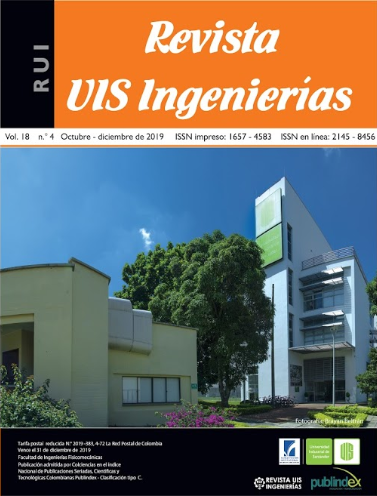Biomechanical workload during manual lifting: A case study on seaport stevedores in Colombia
Published 2019-08-06
Keywords
- seaport stevedores,
- risk assessment matrix (ram),
- manual material handling (mmh),
- lifting index
How to Cite
Copyright (c) 2019 Revista UIS Ingenierías

This work is licensed under a Creative Commons Attribution-NoDerivatives 4.0 International License.
Abstract
Workload related to material handling is one of main biomechanical risks that cause work related musculoskeletal disorder at work. The aim of this study was to assess the risk factors for biomechanical loading present at carried out tasks by port stevedores. First, we made a diagnosis using the risk assessment matrix (RAM) then; we evaluated the biomechanical risk using the NIOSH lifting equation (Compound method). The results were a high level of unacceptable risk at the beginning and at the end of the task (scored 4.22 and 8.50 respectively). Subsequently, we made a correlation analysis between this scored and the musculoskeletal discomfort perceived by stevedores. From this analysis, it is evident that there is a direct relation between lifting vertical distance, trunk torsion, and the increase of musculoskeletal lesions suffered by the dockers. Finally, we proposed some methods to improve the activities of filling and emptying containers and minimize the manual material handling.
Downloads
References
[2] Colombia, Legis, “Los puertos marítimos colombianos se la juegan por la infraestructura,” Revista Logística Portuaria, 2007.
[3] G. J, “Stowage in the port of Barcelona. Business guide occupational risk prevention.,” Spain, 2004.
[4] C. Robaina, T. J. Partanen, and I. Ávila, “A Program for the Reduction of Occupational Injuries and Changes in Safety Culture among Stevedores at Port of Havana, Cuba,” Int. J. Occup. Environ. Health, vol. 16, no. 3, pp. 312–319, Jul. 2010. doi: 10.1179/107735210799160156.
[5] J. H. Verbeek, K.-P. Martimo, P. P. F. M. Kuijer, J. Karppinen, E. Viikari-Juntura, and E.-P. Takala, “Proper manual handling techniques to prevent low back pain, a Cochrane Systematic Review,” Work, vol. 41, no. Supplement 1, pp. 2299–2301, Jan. 2012. doi: 10.3233/WOR-2012-0455-2299.
[6] J. I. Kuiper et al., “Assessing the work-relatedness of nonspecific low-back pain,” Scand. J. Work. Environ. Health, no. 3, pp. 237–243, 2005. doi: 10.5271/sjweh.877.
[7] International Labour Organization, “Prevention of occupational injuries through ergonomics”. Attention to pain Journal, 1997.
[8] World Health Organization, “Prevention of musculoskeletal conditions in the workplace,” Magazine series health protection of workers, 2000.
[9] National Institute of Health and Safety at Work. , “Acute or chronic low back pain.,” 2009.
[10] European Agency for Safety and Health at Work, “Preventing Work-Related Musculoskeletal Disorders,” 2009.
[11] C. Pires, “Ergonomic assessment methodologies in manual handling of loads - opportunities in organizations,” Work, vol. 41, no. Supplement 1, pp. 592–596, Jan. 2012. doi: 10.3233/WOR-2012-0215-592.
[12] I. Kuorinka et al., “Standardised Nordic questionnaires for the analysis of musculoskeletal symptoms,” Appl. Ergon., vol. 18, no. 3, pp. 233–237, 1987. doi: 10.1016/0003-6870(87)90010-X.
[13] E. C. d. P. D. d. R. Integral., “Uso de la matriz de valoración de riesgos – RAM,” 2008.
[14] T. R. Waters, M.-L. Lu, L. A. Piacitelli, D. Werren, and J. A. Deddens, “Efficacy of the Revised NIOSH Lifting Equation to Predict Risk of Low Back Pain Due to Manual Lifting: Expanded Cross-Sectional Analysis,” J. Occup. Environ. Med., vol. 53, no. 9, 2011. doi: 10.1097/JOM.0b013e31822cfe5e.
[15] National Institute of Health and Safety at Work , «Turn your back musculoskeletal disorders.,» 2000.
[16] R. Passmore and J. V. G. A. Durnin, “Human Energy Expenditure,” Physiol. Rev., vol. 35, no. 4, pp. 801–840, Oct. 1955, doi: 10.1152/physrev.1955.35.4.801.
[17] E. M. Almero et al., “A study on the metabolic costs of activities and dietary intake of some construction workers,” Philipp. J. Nutr., vol. 37, pp. 49–56, 1984.
[18] A. Samanta, S. R. Datta, B. N. Roy, A. Chatterjee, And P. K. Mukherjee, “Estimation of maximum permissible loads to be carried by Indians of different ages,” Ergonomics, vol. 30, no. 5, pp. 825–831, May 1987. doi: 10.1080/00140138708969771.
[19] G. Costa, F. Berti, and A. Betta, “Physiological cost of apple-farming activities,” Appl. Ergon., vol. 20, no. 4, pp. 281–286, 1989. doi: 10.1016/0003-6870(89)90191-9.
[20] S. K. Das and H. Saha, “Climbing efficiency with different modes of load carriage.,” Indian J. Med. Res., vol. 54, no. 9, pp. 866–71, Sep. 1966.
[21] M. Vaz, N. Karaolis, A. Draper, and P. Shetty, “A compilation of energy costs of physical activities,” Public Health Nutr., vol. 8, no. 7a, pp. 1153–1183, 2005. doi: 10.1079/PHN2005802.
